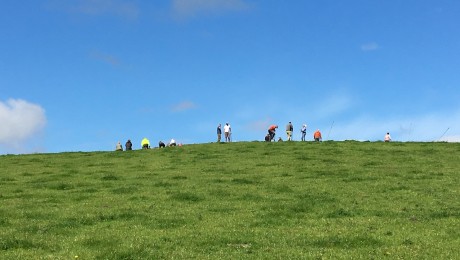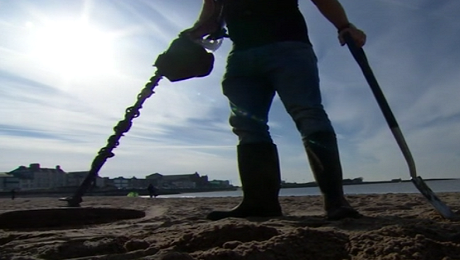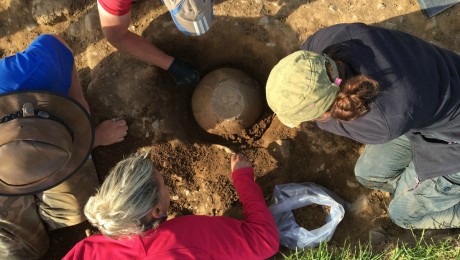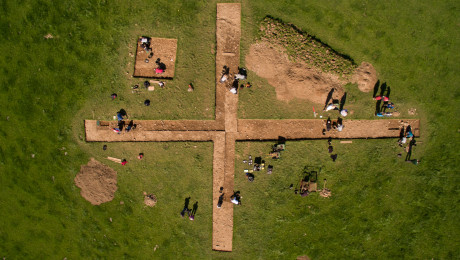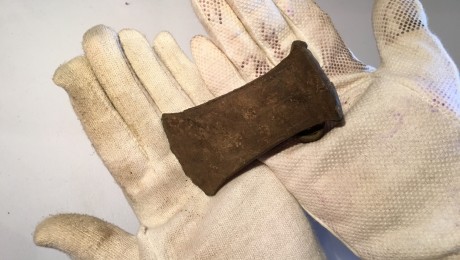The undisturbed Bronze Age monument, found by chance, has kept its secrets for thousands of years. Our excavation is starting to reveal the details of Bronze Age life in North West England.
The sheer importance of the site and what we can learn from it has attracted the attention of some of the country’s most high profile heritage organisations. Supported by the Portable Antiquities Scheme and the Heritage Lottery Fund, DigVentures has secured this very special opportunity to investigate.
So far, the evidence suggests that the Morecambe barrow was built between the Late Neolithic to Early Bronze Age, and remained in continual use right up until the Late Bronze Age. That’s a period of history ranging from 2,500BC–800BC, presenting us with a unique time capsule of data just waiting to be explored.
Although barrows are a common feature in the landscape in southern counties, like Wiltshire, it’s very unusual to find them in the North West of England. As a result, archaeological understanding of round barrows in this region is quite limited – which is something the findings from our excavation will help to change.
Round barrows typically date from 3000BC-1500BC, and can vary dramatically in size, shape and appearance. They’re usually characterised by a mound of earth with a surrounding ditch and an occasional outer bank. The mound often covers underlying structures, like stone cairns and platforms, and is normally associated with one, or even several, burials.
A destructive past
Barrows were amongst the first prehistoric features in the landscape to be recognised by 18th and 19th century antiquarians, and consequently, a large number were destroyed in their attempts to excavate.
Unsurprisingly, this, added to the destruction caused by centuries of agricultural activity, climate change, and settlement expansion, has resulted in very few intact barrows surviving in the landscape today.
This lack of undisturbed evidence means that any further study into these monuments, and how they evolved over time, is made increasingly difficult for modern day archaeologists, who can only piece together a narrative from what little remains.
But this time it’s different…
Incredibly, the monument uncovered near Morecambe Bay appears to be intact, creating this unique and exciting opportunity for us to carry out an in-depth investigation of a complete prehistoric monument.
It’ll be the first major scientific excavation of an Early Bronze Age funerary site in North Lancashire since the 1980s, and the first investigation of an intact barrow in the UK for almost 50 years.
It’s hoped that our investigations will help to fill in the gaps in our knowledge of Bronze Age Britain, specifically in the North West of the country, and help us to learn important information about the construction and purpose of these monuments. We’ll also be helping the local community to learn about, and engage with, a part of their history that’s hidden in the landscape for thousands of years, until now.
What we found in 2016
In 2016, DigVentures’ crowdfunders took up the challenge. With support from some of the UK’s most renowned Bronze Age experts, we began the first full-blown scientific excavation of a barrow in the North West in half a century.
It was delicate operation, but within two weeks we’d already found striking new evidence about its origins over 4,000 years ago. For a start, it seems that the mound may originally have been bright white and taken the form of a ring-cairn. The artefacts we found showed that mourners also brought large chunks of jet, quartz and rock crystal with them, and even flint from as far away as Scotland.
And then, right on the very top of the hill, we found something extraordinary: a large and beautifully decorated Bronze Age urn that had been buried upside-down, and sealed in place with three large stones.
Thousands of people around the world watched as our experts opened it up in the lab, and found it full to the brim with the remains of a seemingly healthy young adult, who had died, been cremated and carefully placed inside with a single stone tool. This was clearly someone very important.
And then came news of the discovery of the Lancaster Hoard, just a few miles away. DigVentures was called in to carry out a brief archaeological evaluation. Our first impression is that it’s well worth coming back to – like the Morecambe Hoard, it appears to be the site of another Bronze Age burial mound.
You can download the official report from the excavation and expert analysis in 2016 on our reports page.
